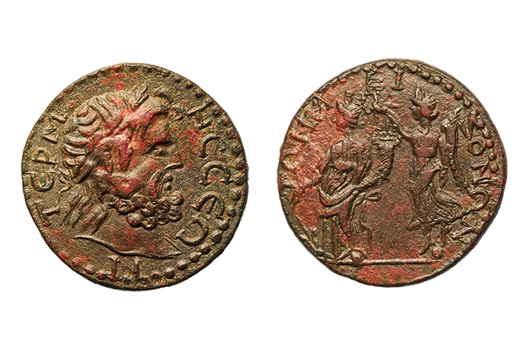
about ancient nomos
Ancient Nomos Art is a museum of galleries exhibiting ancient coins and ancient mint maps. The coin gallery displays the diverse art and history of hand-crafted ancient Greek, Roman, Byzantine, Persian and Medieval coinage. The ancient mints mapping gallery features Greek, Roman, Byzantine, Asia Minor and Medieval mint city regions and territories. Visitor's are welcome to explore, study and enjoy Ancient Nomos Art.

Greek, Pisidia – 3rd C. AD
Termessos Major
From Ancient Galleries

Obverse: Laureate and bearded head of Greek God Zeus facing right; all within a beaded border.
Reverse: Tyche standing on globe facing left, holding rudder plus cornucopia and crowned by Nike.
LEGEND
Obv: TЄΡM – HCCЄΩ – N, Obv: Laureate and bearded head of Zeus facing right. Rev: TΩNM – EI – ZONΩN, Tyche standing on globe facing left, holding rudder and cornucopia, crowned by Nike flying over globe and moving left (behind Tyche). Advancing Nike is holding a wreath in the right hand and palm branch in left.
The ancient city of Termessos (Major), Pisidia, was built high atop the Solymus Mountain (Güllik Dagh) in present day Turkey. The city of Termessos is situated at an altitude of more than 1000 meters above sea level on the south-west side of a range called the Taurus Mountains, in the modern-day Antalya province. The ancient ruins are located about 30 kilometers to the north-west of Antalya. The city was originally founded by the ancient Greeks, who according to legend, claimed Bellerophon (the greatest ancient hero and slayer of monsters), as the mythological founder of Termessos. The ancient city was built on a large natural platform of travertine rock and soars high above the surrounding Antalya valleys. The ruins are concealed by pine forests and preserved by the high altitude, giving the ancient city-site a tangible presence. Many of its distinctive structures, amphitheater and built features are still standing. What is known of Termessos’ history generally commences during the time of Alexander the Great. Alexander was known to have surrounded the Termessos in 333 BC and attempted to subdue and conquer the city. He later describing the city was as an eagle’s nest, with an altitude so high, it made conquering an impossible feat. Arrian, one of the ancient historians who recorded Alexander’s Termessos encounter noted that the insurmountable natural barriers surrounding the city were of strategic importance, allowing even a small Termessos force to easily defend the city. Later, as the Roman Empire expanded, Termessos became a city within the Roman provinces. However, Termessos remained an independent city, while also becoming allied with Rome in the year 71 BC. The Roman Senate favored Termessos and granted the city freedom to rule under its own authority and under its own laws. The Termessos independence was maintained by its Greek citizens continuously well into the 3rd century AD. The minting of its own Greek coinage is a testament to the independent Termessos economy and vitality, well documented by the variety of Termessos bronze denominations and types surviving to this day. Numismatists describe the Termessos coinage as “autonomous” imperial Greek issues because rulers are absent from the legends. Unfortunately, the decline of Termessos occurred rather abruptly when its aqueduct was destroyed by an earthquake, stopping the vital supply of water from flowing into the city. The city was suddenly and quickly abandoned (perhaps in the year 243 AD), which likely explains why its ruins are in a remarkable state of preservation to this day.
DOCUMENTATION
Value: AE 29 mm. Metal: Bronze. Weight: 14.42 grams. Mint: Termessos Major, Pisidia. Date: Early 3rd century BC (before the 243 AD earthquake).
Attribution: SNG France, 2188 variety (obverse letter N under bust); SNG Copenhagen 332; cf. SNG von Aulock 5355.
Legend, Documentation and Attribution
